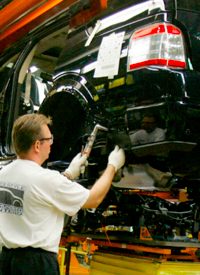
Before the agreement, auto workers were making about $29 an hour, plus benefits (health insurance and a pension plan), which brought the total to $50 an hour or more. The onset of the recession pricked that “high wage bubble” which had been hidden prior to the recession. Under the 2007 agreement, entry-level workers were paid $14 to $16 an hour, plus benefits, bringing their total compensation to about $25 an hour. Although those wages affect only about one in every six workers, it was enough to allow Chrysler to turn a profit last quarter of $212 million, potentially setting the stage for its first profitable year since 2005.
At present it takes between 20 and 30 man-hours to produce a new vehicle. Chrysler’s costs are the lowest of the big three automakers, averaging about $1,250 per vehicle. And so the new wage pact agreed to early this fall will add only a few dollars to the overall price of a new car.
But neither the United Auto Workers (UAW) nor Chrysler is happy about the two-tier system. The UAW insists that paying different wages to people doing the same work isn’t fair. And Chrysler CEO Sergio Marchionne agrees, telling Automotive News, “We need to have one set of wage rates which clearly recognize the participation of our people in the profit generator of our people in the house.” That’s a clumsy way of saying that the big change isn’t wage rates after all, but in allowing workers to share in the profits of the company, giving workers a vested interest in the company’s performance. Buried in the Huffington Post article was this statement: “A new four-year contract that covers 23,000 U.S. factory workers will hold down the company’s costs. It will give workers profit-sharing checks and other bonuses [when the company is profitable] instead of [fixed] annual raises.”
What Marchionne is pushing for is a whole new wage system that includes profit-sharing for workers and a “defined-contribution” retirement plan. What ate the industry alive in the years prior to the start of the great recession was the inevitable rise in labor costs regardless of profitability or productivity. All three carmakers have invested heavily in automation, replacing expensive workers and bringing costs down. Now, with the replacement of fixed pension benefits for the new second-tier workers with company contributions going instead into the workers’ own retirement plans, the ever escalating wage costs will finally be brought under some kind of control.
The new pact signed in September brings the entry-level tier-two wages up to about $19 an hour, or close to $30 an hour including benefits. This is still competitive with Toyota and Honda, who are also seeing their labor costs increase.
The productivity gains are impressive. Plants which once employed 5,000 workers now require less than half that for the same production. For instance, it takes just 900 Chrysler employees to turn out a Jeep Grand Cherokee every 48 seconds of every working day.
The two-tier wage system may be replaced by 2015, the next time contracts are to be renegotiated. Watch for the reality that put in place the two-tier system to continue, resulting in fewer workers making more money and those with jobs having a sizeable vested interest in the profitability of their companies, rather than relying on seniority and union-negotiated fixed benefit retirement plans for their reward.
Photo: AP Images



